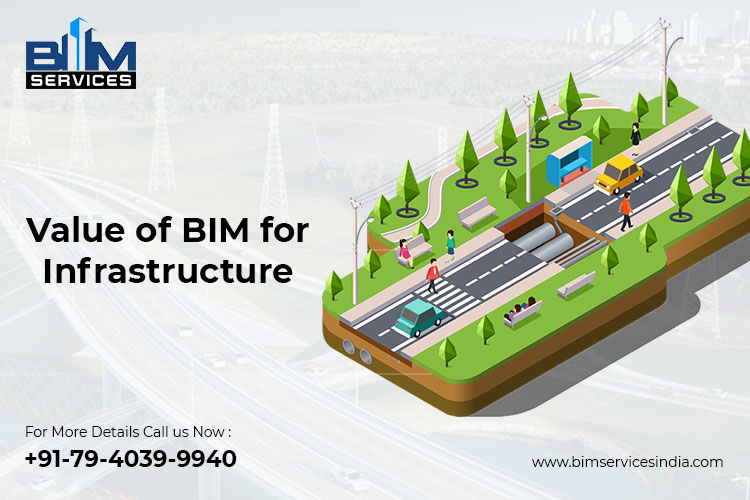Value of BIM for Infrastructure

The Building Information Modeling process has grown into a robust, multi-dimensional tool today. In North America BIM adoption was merely 17% in 2007 but has jumped to more than 70% by 2012. In UK, claims of adoption increased from 10% in 2011 to 70% in 2018. The advantages of BIM are evident and it addresses some of the major concerns that the construction companies are today dealing with. In a report conducted by Mckinsey, lagging construction productivity costs the global economy by $1.6T/yr. Compound that with rework and poor data management the construction companies could face some substantial monetary repercussions. With the amount of investments taking place in infrastructure and transportation steadily rising as well as the scale and the complexity of the projects, AEC companies could gain a variety of gains by utilizing BIM Services for Infrastructure requirements.
BIM provides a Singular Data-base for enhanced project control:
The biggest advantage of BIM is that it allows the civil engineers to feed all the information into a singular model. It includes all the relevant information like cost, scheduling, manufacturer’s details, dimensions etc. This data-rich 3D model can act as a guiding agent throughout the building’s lifecycle- starting from conceptualization to presentation, planning, implementation and construction. The 3D model is knowledge based scalable and visual and can be used to facilitate collaboration, detect clashes, conduct analysis and simulation. Having one singular 3D model that is used throughout the project can increase productivity and reduce errors.
Table of Contents
BIM significantly reduces errors:
Any infrastructure project involves multiple stakeholders and are spread over a large area. With the increase in size and the number of members the errors could also increase. BIM with its enhanced collaboration capabilities makes it possible for multiple stakeholders to work on a single model effectively. It decreases the scope of miscommunication and ensures everyone remains on the same page. Additionally, when it comes to new infrastructure there is also the consideration of existing infrastructure. There are bridges, tunnels, roads etc. already existing and the new infrastructure must not clash with the existing infrastructure in any manner. With proper 3D visualization it is possible to detect such clashes and properly plan and design the new infrastructure. With timely detection of errors a lot of money can be saved onsite.
Cost, Schedule, Labor and Materials Planning
BIM allows for civil engineers to plan and track scheduling and time related information. It optimizes workflows as well as detect any scheduling conflicts which could cause delays and money. With high-profile and time-bound nature of infrastructure projects they can gain great value from BIM. Similarly, infrastructure projects are generally governmental projects that need to operate under a well-publicized budget. Any drastic changes in cost could cause problems for the government and the AEC Company. 5D BIM connects cost with material quantities, so any change in quality of materials leads to an automatic change of cost. It also allows project managers and cost estimators to stay on top of cost related information throughout the duration of the project.
Management and Renovation of existing infrastructure
The challenge for construction professionals is not just to construct new infrastructure but also maintain and renovate the prevailing one. Scan to BIM Services can be crucial on both these fronts. By laser scanning it is possible to get accurate information about the existing condition of the infrastructure and use it to renovate, restore or reconstruct it. The conventional BIM deliverables like 3D visualization, enhanced project control, reduced timeline etc. are extremely important for renovation of infrastructure as the roads, bridges, tunnels etc. are non-functional or partly operational during that time. Similarly, once constructed Point Cloud to BIM can be used to create as-built BIM models that can also be used for facility managers to carry out necessary upgrades and schedule maintenance activities.